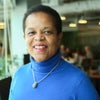
Communities are made up of people. So, the most joyously visible manifestation of the turnaround at the Autumn Ridge apartment complex near Memphis has been the appearance outdoors of the residents themselves.
Formerly locked inside their apartments in fear-based isolation, today they mingle and stroll about freely, their children play in safety and they attend exuberant block parties. Obvious draws attracting the 100-plus residents who show up for these community celebrations are the food, music, door prizes, and talent shows by children and parents -- or even visits by the city's big, red fire trucks. Yet maybe the real underlying reward is the growing sense of a shared community and future.
This is our third blog post on the success of the SAFEWAYS crime-prevention initiative at Autumn Ridge. And as readers may recall, SAFEWAYS is an example of a "community collaborative" -- a growing national approach to address difficult social problems that entails coordination across many stakeholders. Suffice it to say that achieving an 80 percent reduction in crime at Autumn Ridge took extremely close coordination among lots of government, private sector, non-profit and university partners -- not to mention buy-in by its residents.
Indeed, SAFEWAYS has worked so well it is being duplicated at other troubled complexes in Memphis. Plans are even afoot to create a certified version of the model that can be rolled out across the nation with federal backing.
These big outcomes are in line with the high ambitions of the community collaborative approach, which seeks "needling-moving" change of at least 10 percent in tackling such tough social problems as crime, ineffective education and teen pregnancy. Nevertheless, the aim of collaboratives has always been improving the lives of individual people. Doing that on behalf of SAFEWAYS is Twana Whitlock. As the site representative (or "connector") of an overarching services agency called Powerlines, she has been taking the community's pulse through door-to-door visits and chats along walkways and at block parties since late 2009. An extension of the region's Agape Child & Family Services, Whitlock explains that Powerlines promotes "healthy homes in the regional area through community restoration, homeless services, mentoring, foster care, adoption, maternity services and counseling."
Through Powerlines, Whitlock can "connect" residents with such services as health providers, tutoring, transportation to job interviews and unemployment counseling. With a three-room apartment repurposed as her base of operations, Whitlock also holds smaller, formal gatherings called Community Cafes, where she polls groups of 10 to 15 residents on needed services and improvements.
Her motto is: "These are services the community wants, not what agencies think they want." Among others, these include a program on healthy family relationships for 3rd through 8th grade students, a "Dynamic Dads" offering for first-time fathers, life coaching for women, counseling called "Earned Benefits" that offers guidance on how to apply for Food Stamps and other financial aid, after school homework instruction for K-12th grade students, financial literacy, nutrition classes, and a wide variety of health and psychological programs - ranging from diabetes screening and blood-pressure checks to child-abuse prevention training.
Out of her own experience as a teen mother, Whitlock says, "I always wanted to work with youth, especially teen parents, as a means to give back." So it was with a deep sense of personal satisfaction, she says, that the mother of a 15-year-old pregnant girl recently trusted her enough to approach Whitlock at a block party and say, "'I knew I could come to you. How can you help me with my daughter?'"
Whitlock will soon be assisted by two other "connectors." Such outreach workers are already in place at the neighboring apartment complexes of White Haven and Hickory Hill, also a part of SAFEWAYS. Latasha Johns, who has a master's degree in counseling, has served as a supervisor of connectors at another complex since late 2010 and has trained Autumn Ridge's first connector "to hit the ground running."
Like Whitlock, Johns is focused on providing services for teen mothers that range from prenatal care to parenting skills to breast-feeding instruction and on to child development guidelines. To genuinely understand their issues, she has also created a teen-mother support group, now numbering eight young women. "Our mission," she says simply, "is to serve them until their need is met."
Providing such coordinated services that are closely connected to community's needs comprises the core purpose of community collaboratives, as well as the personal mission of the people who bring them to life. It's a hard and demanding job. But as Latasha Johns puts it: "This is not work for me, this is a ministry."
Melody Barnes is the Chair of the Aspen Forum for Community Solutions, former Director of the White House Domestic Policy Council and CEO of Melody Barnes Solutions. Willa Seldon is a partner with The Bridgespan Group and Jennifer Mrowka is a consultant with The Bridgespan Group.
